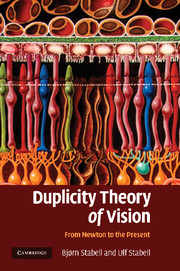Book contents
- Frontmatter
- Contents
- Acknowledgements
- 1 Introduction
- Part I The development of the basic ideas of the duplicity theory from Newton to G. E. Müller
- Part II The development of the duplicity theory from 1930–1966
- 6 The duplicity theory of Polyak
- 7 Investigations of H.K. Hartline and S.W. Kuffler
- 8 The duplicity theory of R. Granit
- 9 Contributions of E.N. Willmer, P. Saugstad & A. Saugstad, and I. Lie
- 10 Status of the duplicity theory in the mid 1960s and its further development
- Part III Chromatic rod vision: a historical account
- Part IV Theories of sensitivity regulation of the rod and cone systems: a historical account
- Part V Factors that triggered the paradigm shifts in the development of the duplicity theory
- References
- Index
9 - Contributions of E.N. Willmer, P. Saugstad & A. Saugstad, and I. Lie
Published online by Cambridge University Press: 22 January 2010
- Frontmatter
- Contents
- Acknowledgements
- 1 Introduction
- Part I The development of the basic ideas of the duplicity theory from Newton to G. E. Müller
- Part II The development of the duplicity theory from 1930–1966
- 6 The duplicity theory of Polyak
- 7 Investigations of H.K. Hartline and S.W. Kuffler
- 8 The duplicity theory of R. Granit
- 9 Contributions of E.N. Willmer, P. Saugstad & A. Saugstad, and I. Lie
- 10 Status of the duplicity theory in the mid 1960s and its further development
- Part III Chromatic rod vision: a historical account
- Part IV Theories of sensitivity regulation of the rod and cone systems: a historical account
- Part V Factors that triggered the paradigm shifts in the development of the duplicity theory
- References
- Index
Summary
The new discoveries of Polyak, Hartline, Kuffler and Granit clearly indicated that the old orthodox formulation of the duplicity theory had serious flaws. In particular, the seminal discovery of Polyak and Granit that rods shared neural pathways with cones appeared to contradict the basic assumption of the theory that rods and cones functioned independently of each other. Obviously, the time was ripe for a reformulation of the theory to make its statements consistent with the new discoveries. In addition to the reformulations proposed by Polyak and Granit (see above), important changes to the theory were made both by Willmer (1946, 1961), Saugstad and Saugstad (1959) and Lie (1963).
Willmer's reformulation represented a quite new version of the duplicity theory. Indeed, he held that the rods under photopic conditions played an important role in trichromatic colour vision.
Saugstad and Saugstad called for a more moderate revision of the theory. They held that its statements should be reformulated making the meaning more explicit. Also, they pointed to well-founded evidence against the theory and concluded that its statements should be qualified by the development of a more comprehensive theory, taking into account the structure and function of the nervous system.
The contributions of Willmer and Saugstad and Saugstad were primarily theoretical. Lie, on the other hand, made a thorough empirical, psychophysical investigation focused on rod-cone interactions in colour vision under mesopic test conditions.
Information
- Type
- Chapter
- Information
- Duplicity Theory of VisionFrom Newton to the Present, pp. 86 - 104Publisher: Cambridge University PressPrint publication year: 2009
